
Reading & Resources
School Administrator, May 2017
Book Reviews
 Dilemmas of Educational Ethics: Cases and Commentaries
Dilemmas of Educational Ethics: Cases and Commentaries
edited by Meira Levinson and Jacob Fay, Harvard Education Press, Cambridge, Mass., 2016, 264 pp. with index, $62 hardcover, $31 softcover
In
Dilemmas of Educational Ethics, Meira Levinson and Jacob Fay explore the ethical challenges all members of the educational community face continually in the changing educational landscape.
The authors and their fellow contributors examine educational ethics through the use of six case studies. All are rooted in the ethical predicaments educators encounter almost daily. Each case is followed by short commentaries written by individuals from all walks of life. Some try to resolve the dilemma, while others answer questions with questions.
The case studies are well written and are up-to-date with examples and anecdotes. The reviews from colleagues are thoughtful and challenging. The verbiage is rich and will make you confront your own previously held beliefs. While the cases studies have an urban connection, the dilemmas they raise apply just as well to rural school settings.
This book will best serve decision-makers in leadership positions who want to analyze all aspects of the ethical challenges before them.
The last chapter gives examples and lesson plan-like activities on how the case studies. This book would best be utilized by study groups, Professional Learning Communities (PLCs), or a doctoral policy level class.
Reviewed by Rob Clark, superintendent, Milton-Freewater Unified School District, Milton-Freewater, Ore.
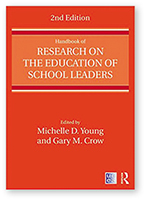 Handbook of Research on the Education of School Leaders
edited by Michelle Young and Gary Crow
Handbook of Research on the Education of School Leaders
edited by Michelle Young and Gary Crow, UCEA, New York, N.Y., 2017, 333 pp., $95.75 softcover
This useful review of research on the preparation of school leaders represents an urgent call for quality research to counter the growing regulatory power of the states and the challenge by entrepreneurs who view education as a market frontier.
On administrator selection, the authors note that there are no peer-reviewed studies that establish a connection between examination scores and leader effectiveness, though a number of states (such as California) currently seek an examination to use in certifying school administrators.
On who is preparing educational leaders, the authors find that faculty at non-research universities are now awarding most of the doctoral degrees in educational leadership, yet do not have content specializations beyond general leadership. This raises questions about what counts as leadership expertise, whose knowledge base is valued, and how university-based leadership preparation programs can stay viable.
This book is essential reading for anyone in the field of leadership preparation.
Reviewed by Louis Wildman, professor of education, California State University-Bakersfield
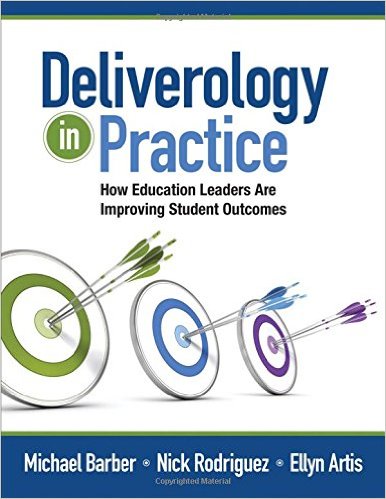 Deliverology in Practice
Deliverology in Practice
by Michael Barber, Nick Rodriguez and Ellyn Artis, Corwin, Thousand Oaks, Calif., 2016, 367 pp. with index, $46.95 softcover
Deliverology in Practice by Michael Barber, Nick Rodriguez and Ellyn Artis is a well written follow-up to the original work,
Deliverology 101.
It is also a field guide, providing the reader with a set of tried and true processes and protocols, which, when implemented with fidelity, have a track record of improving outcomes (deliverables). The work takes the reader on a step-by-step journey through the five-step process of implementation. It describes in detail each step of the process, the roles of each individual tasked with the work and the nature of the work itself.
The book is rich with resources. Every section provides numerous rubrics, flow charts, organization charts, data templates and surveys for a variety of purposes. While the authors provide a website address for an “excellent digital companion,” the web address doesn’t work and it appears that the hosting organization, the U.S. Educational Delivery Institute, has gone out of business. The chapter artifacts, however, are presented using real information from systems that have implemented the Deliverology model. Virtually every section provides a clear summary targeted to the system leader.
This is a valuable work for those seeking to implement systemic change with more success. It is not a book to read alone. As a field guide, it is best read and followed as a precursor and guide to a systemic decision to implement change. Except for the failed link, it is well worth the investment.
Reviewed by Charles Khoury, district superintendent, Ulster BOCES, New Paltz, N.Y.
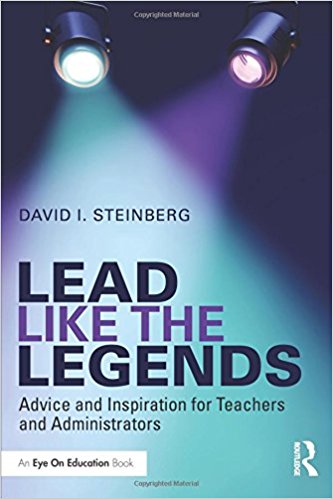 Lead Like the Legends: Advice and Inspiration for Teachers and Administrators
by David I. Steinberg
Lead Like the Legends: Advice and Inspiration for Teachers and Administrators
by David I. Steinberg, Eye on Education, New York, N.Y., 2016, 188 pp., $125 hardcover
Many books have been written for educators that draw exemplary leadership lessons from the business world.
Lead Like the Legends is a departure in that it exemplifies the significant leadership inspiration found in the world of music.
Author David Steinberg is an accomplished musician as well as a career educator and professional speaker. This combination allows him to gather lessons about leadership from those he considers to be music legends and to apply those lessons to leadership in schools using the work of exemplary administrators and teachers to display positive outcomes.
In a series of lessons, Steinberg describes various strategies, including the push to expand human limits, leading with imagination and leading by participation. He draws on legends of the entertainment world — Judy Garland, Frank Sinatra, Bob Dylan, Elvis Presley and The Beatles — to flag particular actions from which we can learn something applicable to education and life itself.
Each section of this book emphasizes a different characteristic of leadership. The reader can turn to any lesson and apply it in an education setting.
Reviewed by Frank Kelly, executive director, Council of Ontario Directors of Education, Oakville, Ontario, Canada
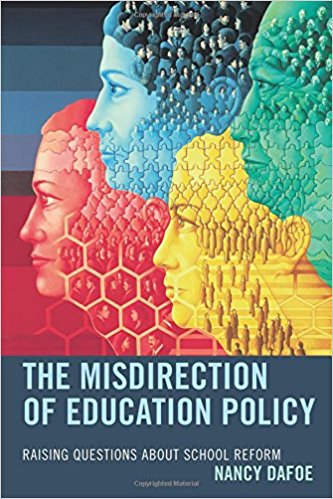 The Misdirection of Education Policy
by Nancy DaFoe
The Misdirection of Education Policy
by Nancy DaFoe, Rowman & Littlefield, Lanham, Md., 2016, 135 pp., $25 softcover
Quite often, public education becomes a whipping boy for all that is wrong or failing in our society and just as often, politicians claim to have the panacea to address this dilemma. The proposed solutions seem cyclic and in the end bear little fruit.
The Misdirection of Education Policy by Nancy DaFoe, who has taught English at the secondary and higher education levels, examines the current state of education reforms and their impact on public education that have been promulgated by both politicians and businesses that might profit from the implementation of these reforms.
The author claims that the shift from traditional schools to charter schools to the privatization of the latter and the proliferation of tests such as PARCC is detrimental to teacher morale. DaFoe further paints the shift towards emphasizing science and technology and subjugating the humanities to aforementioned subjects.
DaFoe presents a sound argument about the need for a well-rounded education instead of a focus on the narrow pathway to the world of work. She also suggests that meaningful reform would best occur with teachers at the classroom level. DaFoe’s arguments in this area are poignant and arguably more to aligned to actual reform.
While most of DaFoe’s argument is grounded, much of her knowledge is based on her experiences in New York and I believe she could have examined the issues on a more national level, citing what is occurring in other states or regions. Another minor complaint about the book is the infusion of fiction and poetry. While creative in its intent, the approach falls flat at times.
Putting these few criticisms aside,
The Misdirection of Education Policy is an insightful view of education reform from the perspective of a classroom teacher.
Reviewed by Marc Space, superintendent, Grants/Cibola County Schools, Grants, N.M.
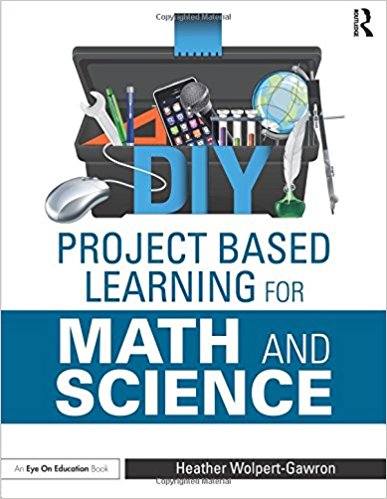 Project Based Learning for Math and Science
by Heather Wolpert-Gawron
Project Based Learning for Math and Science
by Heather Wolpert-Gawron, Routledge Press, New York, N.Y., 2016, 144 pp., $34.95 softcover
Project-based and problem-based learning have risen to the top of the instructional strategy heap in the past half decade. Heather Wolpert-Gawron’s voice strongly projects from the precipice due to her convincing approach.
The author is a middle school teacher — and probably a good one. Her PBL units are clear, connected, practical, and time-tested. She openly shares her entire units, representing the goodness still left in the teaching profession.
This resource is a gold mine for middle school math and science teachers: Common Core State Standards alignments, step-by-step lessons, reproducibles available at the Routledge URL — even what teachers treasure most: completed rubrics and student exemplars.
The second half of the text offers lessons which could be incorporated into a variety of content areas and grade levels. Named “Mix-and-Match Lessons,” these may be helpful fodder for professional developers wanting teachers to see short examples of PBL experiences.
Ideal for a teacher or an instructional coach, this text will not suit the superintendent looking for the theoretical or research base for PBL. Nor will it suffice if the reader is desirous of how to lead a change effort from didactic instruction to PBL environments. However, the read may offer those of us farthest from the classroom a glimpse into what it could really look like.
Reviewed by Thomas Van Soelen, president, Van Soelen & Associates, Lawrenceville, Ga.
ABSTRACT
1:1 Technology
To learn from those who have launched one-to-one educational technology programs, Joshua L. Swanson, a candidate for an Ed.D. at St. Mary’s University in Winona, Minn., interviewed 11 superintendents from public school districts about their experiences.
In his dissertation, Swanson found five recurring themes: competent leader as learner; taking risk and action with an unknown outcome; a sense of duty to grow others; managing pressure in the workplace; and managing new and evolving organizational logistics.
Copies of “Implementing 1:1 Technology in K-12 Schools” are available from ProQuest at 800-521-0600 or
disspub@proquest.com.
Why I Wrote this Book ...

“As an English teacher, I always encouraged my students to write and publish their work to share with a larger audience. So, after so many years, I took my own advice and submitted my collection of poems for publication. … In a world of instant communication, where messages are reduced to fewer and fewer words, abbreviations or symbols, poetry is a concise form that allows for perspective and reflection.”
Nancy Lubarsky, superintendent, Mountainside, N.J., and AASA member since 2013, on writing
The Only Proof (Aldrich Press, 2017)
BITS & PIECES
Cyberbullying
A new
policy brief by Child Trends gives policy recommendations on how to address and prevent bullying and cyberbullying using research from the U.S. Department of Education and other sources.
The report recommends communities adopt a multipronged, coordinated approach.
Best Evidence Newsletter
Best Evidence in Brief, an e-newsletter produced by the Johns Hopkins School of Education’s Center for Research and Reform in Education and the Institute for Effective Education at the University of York, provides a roundup of items of interest related to education research every two weeks.
For more on evidence-based education, visit the
Best Evidence Encyclopedia website. To receive the newsletter, contact
thebee@bestevidence.org.
District Leadership
McREL Institute is hosting a two-day institute on District Leadership That Works, July 17-18 in Denver. This seminar will highlight the responsibilities and actions most connected to student and staff success.
Learn more at
http://conta.cc/2k9HVhe.
Early Parent Support
A
series of briefs addressing the need for research, practice and policy on social and emotional learning by Pennsylvania State University researchers with support from the Robert Wood Johnson Foundation focuses on children’s development during preschool years.
Researchers found several ways to help better prepare disadvantaged children for success in school and diminish the achievement gap.
State Report Cards
The Data Quality Institute has released a
brief examining the user-friendliness of reports detailing school performance in each state, known as state report cards.
The institute found that only four states met the requirements for the report cards as specified in the No Child Left Behind Act introduced 15 years ago and further developed in the subsequent Every Student Succeeds Act.
Evaluation Tool
The U.S. Department of Education’s Office of Educational Technology has created a free evaluation tool for school leaders, the Ed Tech Rapid Cycle Evaluation Coach.
Developed in partnership with Mathematica, it offers schools the ability to determine whether educational technology tools they have piloted are worth further investment based on the school’s goals.
Information is available at
https://tech.ed.gov/rce/.